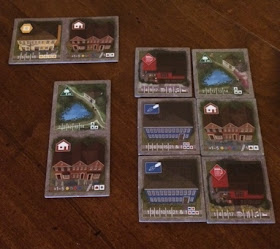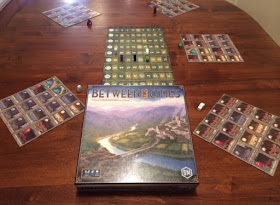So, as you may have noticed, I haven't really written many reviews recently. Yet, after trying Between Two Cities, I decided that I wanted to explore the game some more - including fleshing out my thoughts in writing. (So, here we are!)
In Between Two Cities, you create two (4x4) cities - one with the player on your left, and another with the player on your right. The game is played in three rounds - the first and third round are drafting, and the middle round is simply picking a (larger) tile. Each time that you select a tile, you select two tiles, and everyone reveals their tiles at the same time. Once revealed, you can place either of your tiles in either one of your cities (but one tile must go in each city). Each type of tile has certain ways of maximizing its score, and at the end of the game, your total score is the point value of your lower scoring city. So, the challenge of the game is to balance your two cities so that they both do well - even if it means preventing one of your cities from becoming amazing, in order to allow them both to be great.
The first thing that I like about Between Two Cities is the partnership element of the game. It really has a very unique feel in that you are working with other players all game. (You don't have your own city.) However, this is a double-edged sword. Because, though you're working with two people, each of those players is also working with someone else, and there will be times when they will make a decision that hurts your city, because they feel like it is more important to help their other city. This causes a very strange balance in the game - especially since you are drafting tiles and passing the remaining tiles to one of your partners. Since you know what they are receiving, you can select and place accordingly. But, just because they take the tile that you want them to draft does not mean that they'll actually place it in the city that you both share!
 |
| Placement in the second round is a bit more constrained |
The third thing that I really enjoyed about Between Two Cities was eluded to earlier - I like that when drafting, you are passing your unselected tiles to one of your partners. This knowledge (and foreknowledge) of what tiles are available and can be selected really makes the decision of what to select a bit more intriguing. Obviously, this is still only limited knowledge, in that you don't know what you will draw in future rounds, or what tiles will be passed to you. Yet, this small bit of additional knowledge makes the game feel more strategic.
One thing that I will point out about Between Two Cities that's a bit different from other drafting games is that there isn't really any "hate drafting." What I mean is that there aren't really opportunities to select tiles simply to prevent other people from getting them. There are a couple reasons for this. First, everything that you draft has to go in your city; so if you draft something that's not useful, you're hurting yourself more than your opponent. Secondly, you only select three times in each of the drafting rounds, so the tiles simply don't go that far around the table. It is drafting, but is a much more abbreviated draft than in a game like 7 Wonders.
 |
| Factories make you want more factories! |
Overall, I give Between Two Cities a 9.0/10. I have enjoyed the games of it that I've played so far, and I expect that I'll be playing it many more times. With the speed of setup, explanation, and play - along with the nice 3-7 player count - I see it being easy to get to the table.
I would like to thank Stonemaier Games for providing me with a review copy of Between Two Cities.

No comments:
Post a Comment